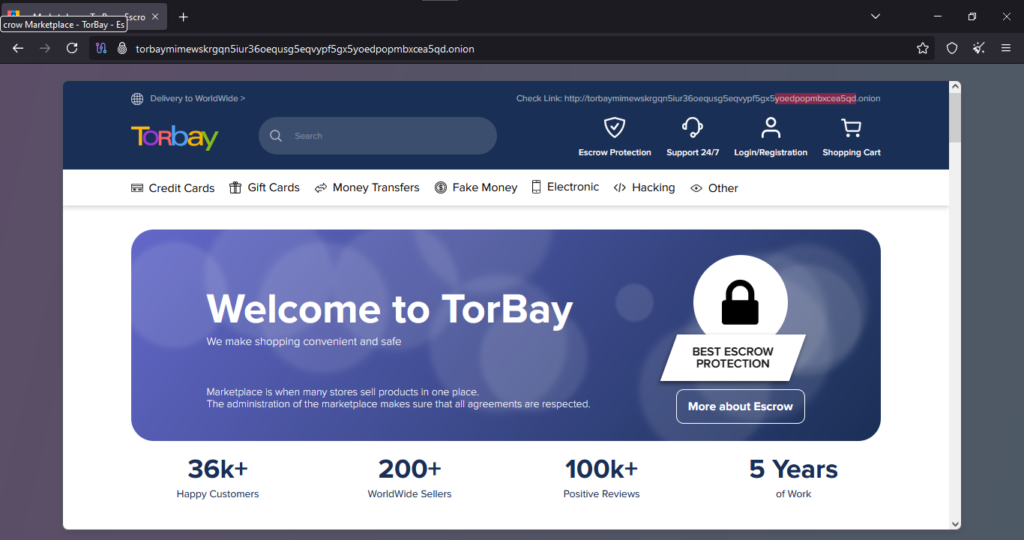Table of Contents
ToggleTorbay – TOR Scam Report (143)
Onion Link : http://torbaymimewskrgqn5iur36oequsg5eqvypf5gx5yoedpopmbxcea5qd.onion
Scam Report Date : 2025-01-28
Client Scam Report Breakdown
Original Scam Report :
The client’s scam report is a straightforward but concerning case of non-delivery fraud, where they paid $75 for a purchase but never received the product or service. it highlights a common scam in online marketplaces—where a vendor accepts payment but fails to deliver the promised item. The lack of any additional details, such as the payment method used or attempts to contact the seller, suggests that the buyer either had no recourse for a refund or was completely ignored after making the transaction. This scam is particularly prevalent in unregulated online marketplaces, deep web platforms, and fraudulent storefronts, where vendors operate anonymously and avoid accountability.
2. Defining Terminology and Key Elements
To fully understand this scam report, it’s important to define the key elements involved:
- Non-Delivery Fraud: This is a type of scam where a seller advertises a product or service, takes payment, and then fails to deliver the item, often disappearing after receiving the money. It is one of the most common forms of e-commerce fraud.
- Transactional Loss: This refers to the financial damage suffered by the buyer. In this case, the client lost $75, but similar scams can range from small losses to thousands of dollars, depending on the platform and the type of product involved.
- Unregulated Online Marketplaces: Many scam websites and deep web marketplaces operate outside of traditional legal frameworks, making it difficult to track vendors or hold them accountable. These platforms often lack buyer protections, dispute resolution processes, or enforceable refund policies.
- Cryptocurrency or Irreversible Payments: Although the report does not specify the payment method, scams of this nature often involve Bitcoin or other cryptocurrencies, which offer no chargeback options. Scammers prefer these methods because they provide anonymity and make it nearly impossible for victims to recover their funds.
By defining these terms, we gain a clearer picture of the mechanics of this scam. The vendor likely set up a storefront to appear legitimate, took payment, and then disappeared without fulfilling the order. The victim, in turn, was left without any way to reclaim their funds.
3. Segment Analysis and Implications
This case serves as a warning about the risks of unverified online transactions. The simplicity of the report—stating only that a purchase was made and never received—suggests that the victim may not have had any protection or a way to escalate the issue. Many scams operate under this model, targeting buyers who assume that the marketplace or vendor will honor their purchase. However, without a legitimate buyer protection policy, escrow system, or verifiable reputation, transactions like these become high-risk.
Additionally, the lack of seller communication is a key red flag. In legitimate e-commerce settings, a seller would respond to inquiries, provide tracking details, or offer a resolution. However, in fraudulent marketplaces, sellers often ignore or block communication attempts after taking payment, leaving victims with no recourse. If the purchase was made using irreversible payment methods like cryptocurrency, cash transfers, or prepaid gift cards, the likelihood of recovering the funds is close to zero.
To avoid scams like this, buyers should take several precautions:
- Verify the seller’s reputation before making a purchase, especially in unregulated marketplaces.
- Use platforms with buyer protection and dispute resolution policies to ensure a way to recover lost funds.
- Avoid irreversible payment methods, such as Bitcoin or gift cards, unless absolutely necessary and only if the vendor has a strong track record of legitimate transactions.
- Look for third-party reviews of the website or vendor to see if others have reported similar scams.
This report serves as yet another example of how non-delivery scams exploit trust in online transactions, emphasizing the need for buyer awareness and marketplace accountability.







